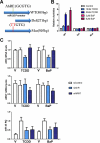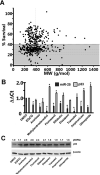Regulation of p53-targeting microRNAs by polycyclic aromatic hydrocarbons: Implications in the etiology of multiple myeloma
- PMID: 24798859
- PMCID: PMC4223015
- DOI: 10.1002/mc.22175
Regulation of p53-targeting microRNAs by polycyclic aromatic hydrocarbons: Implications in the etiology of multiple myeloma
Abstract
Multiple myeloma (MM) is a common and deadly cancer of blood plasma cells. A unique feature of MM is the extremely low somatic mutation rate of the p53 tumor suppressor gene, in sharp contrast with about half of all human cancers where this gene is frequently mutated. Eleven miRNAs have been reported to repress p53 through direct interaction with the 3' untranslated region. The expression of nine of them is higher in MM plasma cells than in healthy donor counterparts, suggesting that miRNA overexpression is responsible for p53 inactivation in MM. Here, we report that the environmental carcinogen benzo[a]pyrene (BaP) upregulated the expression of seven p53-targeting miRNAs (miR-25, miR-15a, miR-16, miR-92, miR-125b, miR-141, and miR-200a), while 2,3,7,8-tetrachlorodibenzo-ρ-dioxin (TCDD) upregulated two of them (miR-25 and miR-92) in MM cells. The miR-25 promoter was activated by both BaP and TCDD, and this response was mediated by the aryl hydrocarbon receptor (AhR). We screened 727 compounds that inhibit MM cell survival and down-regulate the expression of p53-targeting miRNAs. We found that (-)-epigallocatechin-3-gallate (EGCG), a constituent of green tea and a major component of the botanical drug Polyphenon® E, reduced the expression of four p53-targeting miRNAs, including miR-25, miR-92, miR-141, and miR-200a. Collectively, these data implicate polycyclic aromatic hydrocarbons and AhR in the regulation of p53-targeting miRNAs in MM and identify a potential therapeutic and preventive agent to combat this deadly disease.
Keywords: microRNAs; multiple myeloma; p53; polycyclic aromatic hydrocarbons; toxicants.
© 2014 Wiley Periodicals, Inc.
Figures





Similar articles
-
A p53-dependent tumor suppressor network is induced by selective miR-125a-5p inhibition in multiple myeloma cells.J Cell Physiol. 2014 Dec;229(12):2106-16. doi: 10.1002/jcp.24669. J Cell Physiol. 2014. PMID: 24819167
-
Polycyclic aromatic hydrocarbons stimulate human CYP3A4 promoter activity via PXR.Toxicol Lett. 2013 Oct 24;222(2):180-8. doi: 10.1016/j.toxlet.2013.06.243. Epub 2013 Jul 8. Toxicol Lett. 2013. PMID: 23845848
-
Activation of the aromatic hydrocarbon receptor pathway is not sufficient for transcriptional repression of BRCA-1: requirements for metabolism of benzo[a]pyrene to 7r,8t-dihydroxy-9t,10-epoxy-7,8,9,10-tetrahydrobenzo[a]pyrene.Cancer Res. 2002 Jan 1;62(1):113-21. Cancer Res. 2002. PMID: 11782367
-
Role of tumor suppressor p53 and micro-RNA interplay in multiple myeloma pathogenesis.J Hematol Oncol. 2017 Oct 26;10(1):169. doi: 10.1186/s13045-017-0538-4. J Hematol Oncol. 2017. PMID: 29073933 Free PMC article. Review.
-
The dichotomy of p53 regulation by noncoding RNAs.J Mol Cell Biol. 2014 Jun;6(3):198-205. doi: 10.1093/jmcb/mju017. Epub 2014 Apr 4. J Mol Cell Biol. 2014. PMID: 24706938 Free PMC article. Review.
Cited by
-
ZEBRAFISH AS AN IN VIVO MODEL FOR SUSTAINABLE CHEMICAL DESIGN.Green Chem. 2016 Dec 21;18(24):6410-6430. doi: 10.1039/C6GC02061E. Epub 2016 Oct 21. Green Chem. 2016. PMID: 28461781 Free PMC article.
-
Nano-Based Drug Delivery of Polyphenolic Compounds for Cancer Treatment: Progress, Opportunities, and Challenges.Pharmaceuticals (Basel). 2023 Jan 10;16(1):101. doi: 10.3390/ph16010101. Pharmaceuticals (Basel). 2023. PMID: 36678599 Free PMC article. Review.
-
Epigenetic alterations induced by genotoxic occupational and environmental human chemical carcinogens: A systematic literature review.Mutat Res Rev Mutat Res. 2016 Apr-Jun;768:27-45. doi: 10.1016/j.mrrev.2016.03.004. Epub 2016 Mar 31. Mutat Res Rev Mutat Res. 2016. PMID: 27234561 Free PMC article.
-
Exposure to polycyclic aromatic hydrocarbons derived from vehicle exhaust gas induces premature senescence in mouse lung fibroblast cells.Mol Med Rep. 2019 May;19(5):4326-4334. doi: 10.3892/mmr.2019.10086. Epub 2019 Mar 26. Mol Med Rep. 2019. PMID: 30942392 Free PMC article.
-
Using ncRNAs as Tools in Cancer Diagnosis and Treatment-The Way towards Personalized Medicine to Improve Patients' Health.Int J Mol Sci. 2022 Aug 19;23(16):9353. doi: 10.3390/ijms23169353. Int J Mol Sci. 2022. PMID: 36012617 Free PMC article. Review.
References
-
- Shimizu Y, Kato H, Schull WJ. Studies of the mortality of A-bomb survivors. 9. Mortality, 1950-1985: Part 2. Cancer mortality based on the recently revised doses (DS86). Radiat Res. 1990;121(2):120–141. - PubMed
-
- Williams RR, Horm JW. Association of cancer sites with tobacco and alcohol consumption and socioeconomic status of patients: interview study from the Third National Cancer Survey. J Natl Cancer Inst. 1977;58(3):525–547. - PubMed
-
- Mills PK, Newell GR, Beeson WL, Fraser GE, Phillips RL. History of Cigarette Smoking and Risk of Leukemia and Myeloma: Results From the Adventist Health Study. Journal of the National Cancer Institute. 1990;82(23):1832–1836. - PubMed
-
- Fernberg P, Odenbro A, Bellocco R, et al. Tobacco use, body mass index, and the risk of leukemia and multiple myeloma: a nationwide cohort study in Sweden. Cancer Res. 2007;67(12):5983–5986. - PubMed
-
- Psaltopoulou T, Sergentanis TN, Kanellias N, Kanavidis P, Terpos E, Dimopoulos MA. Tobacco smoking and risk of multiple myeloma: A meta-analysis of 40 observational studies. International Journal of Cancer. 2012:n/a–n/a. - PubMed
Publication types
MeSH terms
Substances
Grants and funding
LinkOut - more resources
Full Text Sources
Other Literature Sources
Medical
Research Materials
Miscellaneous

